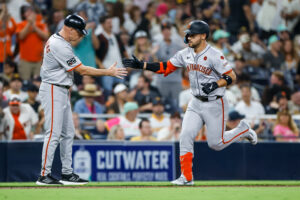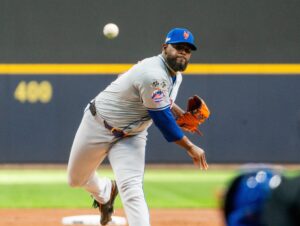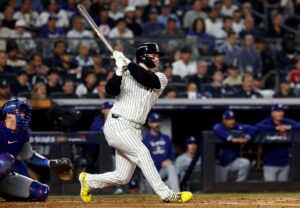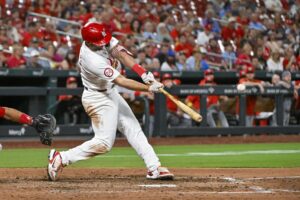Why the 2021 MVP Finalists Truly Were the Most Valuable
MLB Network announced the awards finalists — the top three vote-getters in each league’s award category — Monday night. Each announcement provoked passionate discussion. The Most Valuable Player (MVP) finalists, heavily discussed every year, provoked unusually intense discussion. Most surprising (to some) is that none of the six finalists came from a team that made the playoffs. This guarantees that the MVP in both leagues will be from teams that did not make the playoffs. That has not happened since 1987, when each league had two divisions and only the four division winners made the playoffs.
A big point of contention came over the definition of “valuable,” with many saying that a player can’t be valuable if he doesn’t get his team to the postseason. “Valuable” has been debated for many years, namely because it was so hard to quantify “value.” However, there is a stat many aren’t aware of that does quantify on-field value in an objective way — Win Probability Added (WPA).
Surprised that it isn’t WAR (Wins Above Replacement)? WAR means something different to almost everyone, especially because different sources calculate it in different ways. Furthermore, which traits are valued, and to what extent, varies by the person and by the website. WPA, however, is completely objective. It also focuses on what a player’s in-game performance did specifically to help his team’s chances of winning. We’ll try to keep this explanation as brief as possible.
WPA, LI, and Situational Wins
The basis of WPA is straightforward. Every single base-out situation (which bases are occupied, how many outs there are), along with its half-inning and the score difference, has a win probability (or Win Expectancy (WE)) attached to it. We have detailed records of the hundreds of thousands of baseball games in the history of Major League Baseball, so we know what percentage of the time that the offensive and defensive teams go on to win the game. That is Win Probability (WP or WE). The difference between the WP before the at-bat and after the at-bat is the WPA. For example, say it is the bottom of the first of a scoreless game. When the leadoff hitter comes to bat, his team’s WP is 55%. If he singles, the WP becomes 58%, so his WPA for that play is + .030. The pitcher’s WPA for that play, conversely, is –.030.
Keeping It Fair
Keeping track of WPA can quickly show who was the most valuable player in a game. It also works well for an entire series or an entire postseason. However, going much longer than that brings up a problem. To illustrate, let’s look at Kirk Gibson’s famous walk-off home run in Game One of the 1988 World Series. Before the 3–2 slider from Dennis Eckersley, the Oakland A’s had an 87% WP. The situation was runner on second, two out, visiting team ahead by one. If Gibson made an out, Oakland’s WP would have become 100%, giving Gibson –.130 WPA. Instead, Gibson homered, changing Oakland’s WP to 0% and the Dodgers’ WP to 100%. That gave Gibson +.870 WPA. Because that one at-bat had such a wide potential swing in WP, that is a “high-leverage” situation. The leverage of a situation is measured by Leverage Index (LI).
Long-term, if a certain player continually comes to the plate as a late-game pinch-hitter with the game on the line, his WPA has the potential to be a giant see-saw. If he hits so much as two home runs in that situation, his WPA will skyrocket. On the other hand, multiple outs in that situation will make his WPA plummet. In order to correct for this, we have a stat called Situational Wins. This takes a player’s WPA and divides it by LI.
Situational Wins Leaders and the 2021 MVP Finalists
Here is the National League leaderboard for WPA. Position players and pitchers are mixed together. The Situational Win number listed for position players is for batting, and for pitchers, it is solely for their pitching. Look specifically at the top three. They should be familiar.
| Rank | Name | Team | Pos | Sit Wins |
| 1 | Bryce Harper | PHI | OF |
6.1 |
| 2 | Juan Soto | WSN | OF |
5.6 |
| 3 | Fernando Tatis Jr. | SDP | IF/OF |
4.9 |
| 4 | Paul Goldschmidt | STL | 1B |
4.7 |
| 5 | Corbin Burnes | MIL | P |
4.5 |
According to this, the National League Finalists, despite their teams not making the postseason, really were the top three most valuable players. Yes, off-the-field factors need to be considered, but none of them are currently a clubhouse cancer. Also according to this, Harper has a significant lead — .500. The American League also has familiar names at the top. Since Shohei Ohtani is a two-way player, his batting and pitching Situational Wins have been added together. He has 4.8 as a hitter (second for batting) and 1.9 as a pitcher (tied with Jonathan Loaisiga for 12th among AL pitchers). According to this statistic, Marcus Semien should not be a finalist; Matt Olson should be instead. However, this statistic supports the candidacy of Ohtani and Vladimir Guerrero Jr.
| Rank | Name | Team | Pos | Sit Wins |
| 1 | Shohei Ohtani | LAA | P/OF |
6.7 |
| 2 | Vladimir Guerrero Jr. | TOR | IF |
5.0 |
| 3 | Matt Olson | OAK | 1B |
4.0 |
| 4 | Aaron Judge | NYY | OF |
3.7 |
| 5 | Brandon Lowe | TBR | IF/OF |
3.6 |
| 6 | Cedric Mullins | BAL | OF |
3.1 |
| 7 (T) | Lance Lynn | CHW | P |
3.0 |
| 7 (T) | Carlos Rodon | CHW | P |
3.0 |
| 9 | Marcus Semien | TOR | IF |
2.9 |
| 10 (T) | Jose Berrios | MIN/TOR | P |
2.8 |
| 10 (T) | Gerrit Cole | NYY | P |
2.8 |
2021 MVP Finalists and Beyond
What constitutes “most valuable” will always be debated. However, the fact that an objective stat can quantify who truly did the most to help his team win can certainly be a game-changer. Some advanced stats solely give information that is in the category of “Oh, That’s Interesting.” Others actually serve a useful purpose by answering pertinent questions that more traditional statistics can’t. Win Probability (Win Expectancy), WPA, Leverage Index, and Situational Wins fit in the latter category. Now that they’re becoming more well-known, expect to see a team’s year-long record become less of a factor in the MVP vote. It’s yet another way that baseball is evolving for the better.
Main Photo:
Players Mentioned:
Kirk Gibson, Dennis Eckersley, Bryce Harper, Juan Soto, Fernando Tatis Jr., Paul Goldschmidt, Corbin Burnes, Shohei Ohtani, Jonathan Loaisiga, Marcus Semien, Matt Olson, Vladimir Guerrero Jr, Aaron Judge, Brandon Lowe, Cedric Mullins, Lance Lynn, Carlos Rodon, Jose Berrios, Gerrit Cole






